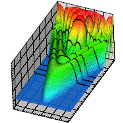Department of Physics and Astronomy: Publications and Other Research

Anthony F. Starace Publications
Document Type
Article
Date of this Version
8-1-2001
Abstract
Our recent analysis [J. Phys. B 33, R141 (2000)] of the problem of H- in both laser and strong static electric fields, which treated effects that are linear in the laser intensity l (e.g., the dynamic polarizability and the single-photon detachment cross section), is extended here to treat effects of higher order (∼l2) in the laser intensity (e.g., the dynamic hyperpolarizability, the two-photon detachment cross section, the linear in l corrections to the single-photon detachment rate, etc). We introduce the concept of the dynamic hyperpolarizability of an atom in the presence of a strong electric field based on the complex quasienergy approach with properly normalized, quasistationary quasienergy wave functions. Our analysis of the general structure of the dynamic hyperpolarizability tensor of an atom in a nondegenerate (S-) state is performed for arbitrary field geometries and laser polarizations. The connection of the hyperpolarizability γ(F;ω) to the complex quasienergy and to atomic ionization rates is established. Analytic results (in terms of Airy functions) are obtained for five irreducible components of a hyperpolarizability tensor (that are independent of the laser polarization and the field geometry) for the case of a weakly bound electron in a three-dimensional, zero-range potential. These results are used for the analysis of the frequency, field geometry, and laser polarization dependence of the two-photon detachment rate as well as of the linear in laser intensity corrections to the single-photon detachment rate. It is shown that the oscillatory behavior of the frequency dependence of both the real and the imaginary parts of γ(F;ω) exists for both the coplanar and orthogonal field geometries, and that this behavior is qualitatively different for frequencies below and above the single-photon detachment threshold. The threshold behavior of the two-photon detachment rate is analyzed in detail and the static electric-field-induced modification of Wigner’s threshold law for a short-range potential is discussed.


Comments
Published by American Physical Society. Phys. Rev. A 64, 023417 (2001). http://pra.aps.org. Copyright © 2001 American Physical Society. Permission to use.